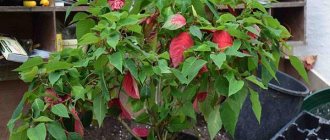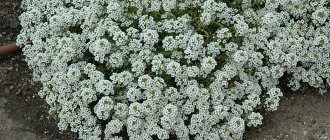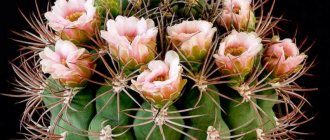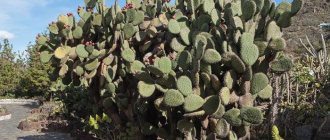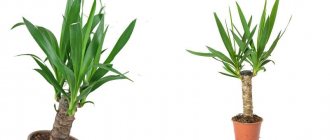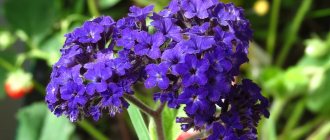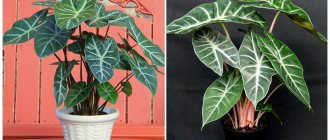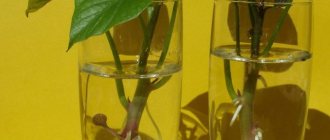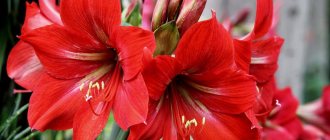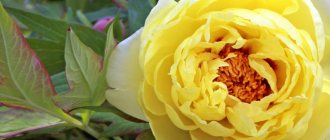Echinocactus is a spherical succulent common in the deserts of Central America. Other the name of this genus is hedgehog cactus, from the Greek word for hedgehog - echinos.
It is bred as a house and garden plant, takes root well in slightly acidic porous soil, but is sensitive to frost and dies from low temperatures.
Types of Echinocacti
There are 6 types, each of which has characteristic differences.
Echinocactus grusonii (Gruzoni)
Endemic to eastern and central Mexico, but rare in the wild and endangered. Habitat: basalt substrate on the slopes of hills, at an altitude of about 1,400 m.
It was first described by the German botanist Heinrich Hildmann, who named the species in honor of his compatriot Hermann Gruson
Outwardly it resembles a large, almost regular ball. After many years it reaches a meter in size. Young specimens differ in appearance from mature ones. Life expectancy is approximately 30 years.
Adults may have up to 35 distinct ribs, although in the initial stages of growth only small projections are noticeable. The sharp, long spines are usually straight or slightly curved and come in shades of yellow and sometimes white.
After reaching approximately 20 years of age, small yellow flowers appear on Gruzoni's crown each summer.
Echinocactus platyacanthus (broad-spined or flat-spined)
Comes from the Chihuahuan Desert. Residents of Mexico prepare traditional sweets from it by boiling the pulp. The plant reaches a height of 2.5 m and a width of 1.5 m. It lives for more than a hundred years. It has a grayish-blue stem with hard spines.
The top is flat and covered with a yellow fibrous texture. There is strong ribbing and large areolas. The flowers bloom at the turn of the spring and summer seasons and bear small, hairy fruits.
Echinocactus parryi (parry)
Oblate-spherical or short cylinder-shaped, morphologically reminiscent of polycephalus. The plant has a grey-green stem 20–30 cm long with distinct ridges. The needles are white or pinkish, arranged in bunches, almost completely covering the plant. Flowering occurs in summer.
Echinocactus horizonthalonius (horizontal)
Natural environment - limestone substrates of the Sonoran and Chihuahuan deserts. The color varies from gray-green to bluish-gray, and the shape is spherical, hemispherical , cylindrical or oblate.
Extends up to 45 cm with a width of 20. Consists of sections that bend slightly around the longitudinal axis, like a screw. Bright pink or purple-red flowers, 7–9 cm in diameter, bloom in June. The buds open in the middle of the day and close at night.
Echinocactus polycephalus (multi-headed)
Homeland - the most arid regions of the American continent - the Mojave Desert and the northern part of Sonora.
It can be solitary, but more often it forms clusters of up to 30 specimens, each up to 0.6 m in height. Frequent, strong spines cover the stem and prevent the buds from fully opening. Flowering period – July. Brown needles turn red from moisture.
The cactus finds it difficult to take root due to its weak roots.
Echinocactus texensis (Texas)
True to its name, it comes from Texas and surrounding areas.
The cactus is hardy: solitary in the early stages of growth, occasionally forming clusters over the years. Shade options range from gray-green to grassy. The plant has many ribs. The aboveground part is hemispherical, with a flat top.
Small but hard spines grow in bunches. As a rule, the Texas subspecies sits deep in the ground, rising above the surface by about 20 cm with a diameter of 30. It blooms easily, takes root well , and is more frost-resistant than other species.
3.Varieties:
3.1. Echinocactus Grusonii - Echinocactus grusonii
Attractive cacti with spherical, dark green, sometimes slightly flattened stems. The stems reach a height of 180 cm in their natural environment, often without losing their rounded shape. The ribs are numerous, vertical, and bear many halos. With age, numerous lateral shoots may appear at the base of the plant. The areoles are located on the surface of the ribs and have straight, sharp, golden or white spines. At the tops of the stems there is an attractive golden-yellow cephalium. During the flowering period, this cactus decorates itself with a floral wreath consisting of small, funnel-shaped, yellow flowers. When grown indoors, the height of plants often does not exceed 50 cm.
↑ Up,
3.2.Echinocactus Rainbow - Echinocactus grusonii Rainbow
Globular cacti with numerous vertical ribs on a glossy, dark green stem. In flower shops, these plants are often sold with bright, colorful spines. With age, the stems of these cacti take on a cylindrical shape.
↑ Up,
3.3. Horizontal Echinocactus - Echinocactus horizonthalonius
Very attractive single cacti with slightly elongated, light green, bluish-green stems up to 30 cm in height and about 15 - 20 cm in diameter. The ribs are vertical, widely spaced, and shallow. The areoles are often woolly and bear very strong, thick, sometimes flat, light brown or gray spines. The flowers appear in the summer months at the tops of the shoots, in a fluffy cephalium, and are funnel-shaped from many silky, oblong pink or white petals. The flowers reach 5–9 cm in diameter.
↑ Up,
How to care for Echinocactus Gruzoni
This species is also known as Echinocactus Grusona. It adapts to the artificial environment more easily than its fellows, as a result of which it has become the most common representative of the genus among domestic cacti.
There are copies of alternative colors on sale - Gruzoni red or Gruzoni rainbow, but the most common shade remains golden.
Lighting
When placed outdoors, it requires plenty of sun: the plant should be kept open or in partial shade if exposed to bright sun. In the room, the cactus is located at a point with increased access to daylight and direct sunlight.
Tolerates moderate shade. After a long stay in the shade, gradual adaptation is required before fully exposing the plant to the sun. Otherwise there is a risk of severe damage.
Temperature
Can tolerate brief periods of frost, provided the cold is not severe. For the safety of Gruzoni, it is recommended to provide frost protection if the temperature is expected to drop .
Watering
Regular watering is required throughout the summer growth cycle. There should be enough water, but not too much: the soil should be allowed to dry before adding the next portion. Avoid getting moisture on the stem exposed to the sun. This will cause burns and scars , and possibly fungal infection and death. Winter watering is sporadic; most of the time the cactus is kept dry. Stagnation of water around the roots is unacceptable at any time of the year.
The soil
Saturated, porous soil with a small humus content is suitable for Gruzoni. When kept in a pot, if the roots are cramped, replanting is preferable in the spring. To ensure the freshness of the soil, the procedure is carried out annually.
However, a larger vessel is not always necessary. Up to a quarter of the volume is filled with crushed stone and gravel to maintain the required permeability . In summer, fertilizer with a high potassium content is added.
Choosing a pot
The size of the vessel is not too large, otherwise rot will develop in the roots. At the same time, the plant should not be crowded. It is necessary to provide a shallow but sufficient depth to accommodate the drainage layer and soil. The latter should conduct moisture well and not remain damp for a long time. When the pot becomes too small, a replacement is selected not to spare, but according to size, in order to eliminate problems with the roots.
This video explains how to care for echinocactus gruzoni at home.
Planting and transplanting
Replanting after purchase (important aspects):
- the size of the hole is at least twice the volume of the root system;
- distance to nearest neighbors. If the location is chosen in the garden , then the distance should be at least 2.5 times the circumference of the cactus;
- drainage made of quartz sand or crushed stone is laid on top of the ground;
- the soil is pressed down to eliminate potential voids ;
- The first watering should be plentiful.
When Gruzoni is placed in the garden, the owner first allows it to adapt to unfiltered solar radiation. The cactus is exposed daily for at least a week . The duration of sessions starts from 1 hour and gradually increases.
Attention! Only adult representatives of the species are able to tolerate intense radiation and midday heat.
Replanting means stress for the plant and is not done without reason. The reason is depletion of the nutrient medium, as well as excessive growth of roots when they become visible on the surface or in drainage holes. During the moving process, the adhered substrate is carefully removed. The diameter of the new vessel should be approximately 3 cm larger than the old one.
Description
Echinocactus belongs to the cactus family. It grows naturally in the desert areas of Mexico and the Southwestern United States. Echinocactus Gruzoni is the most common species both in nature and in indoor floriculture. The locals call this perennial, slow-growing plant “hedgehog cactus.” Indeed, echinocactus resembles a hedgehog in its shape and spines. The name Echinocactus was named after Hermann Gruzoni, a German inventor and collector of these prickly plants.
Echinocactus grows to very large sizes in the wild
Echinocactus Gruzoni in natural conditions grows to gigantic sizes, reaching a height of up to one and a half meters and a width of up to a meter. The cactus is a long-livers, growing up to 200-500 years. As the plant grows, it changes from a ball shape to a barrel. Therefore, its second name is “golden barrel”. It should be noted that as they grow older, the appearance of the echinocactus changes. After three to four years, the small tubercles become sharp ribs covered with dense, sharp spines. The growing upper part is first covered with “fluff” - young, not yet hardened spines.
So, the echinocactus Gruzoni is a spherical stem covered with sharp ribs located vertically. The number of ribs ranges from thirty-five to forty-five. The surface of the stem is glossy and green. On the ribs there are areoles, from which spines grow in a bunch. Each areola contains radial spines (about ten) and central spines (from one to four). The length of the spines is from three to five centimeters. The central spines are longer than the radial ones. On the growing top, a “hat” of young spines resembling fluff looks beautiful. The color of the spines varies from white to yellowish.
Attention! In nature, there are no Gruzoni echinocacti with red, green, or bright yellow spines. Such specimens are grown for sale using dyes. In the best case, the plant will acquire its natural color over time. And if you use harmful paints, the cactus begins to hurt and may die.
In indoor conditions, echinocactus grows up to 40-60 centimeters in height and 40 in diameter. But to reach such a size, it will take more than a dozen years.
Blooming Echinocactus Gruzoni
Waiting for flowering will also be difficult, because they bloom after twenty years. The cactus blooms in May-June. First, a bud appears at the top, on a long stalk, from which a yellow flower blooms. The flower tube is funnel-shaped, pubescent on the outside. The petals are thin and glossy. Closer to the edge of the petals, their color becomes darker, acquiring a brown tint. The corolla of the flower reaches 7 cm in length and 5 cm in diameter.
Diseases and pests
Gruzoni has good disease resistance. They are usually caused by improper or overly careful care. The main negative factor is moisture saturation - excess will quickly cause rotting.
Shchitovka
Infestation by scale insects is indicated by the appearance of brown spots of foreign material. Such scales are easy to pick up and separate from the stem , which confirms the presence of a pest. The solution to the problem is to treat the surface of the cactus with cotton wool soaked in alcohol. Another method for more serious cases is insecticide treatment.
Cactus mite
A small arthropod almost invisible to the naked eye. A sign of infection is the formation of a brown rash on the cactus. For control, special means are used to kill ticks - acaricides. To prevent relapse, a second one is done a week after the first treatment.
Chervetsy
Noticing a white coating between the sections and on the areoles, the owner of the cactus begins to prepare to counteract the scale insects. Signs appear at a later stage of the infestation as the pests first settle in the root area. An earlier symptom will be causeless darkening of the stem.
Getting rid of insects is relatively easy. The plaque is washed off in the shower, and then the plant is sprayed with a mixture of soap suds and a little alcohol. The procedure must be carried out daily for a week or more. You can use vinegar instead of alcohol.
Attention! Suspicion of scale insects, like other pests, is a reason for immediate quarantine to avoid migration to other plants.
Features of the plant
Echinocactus Gruzoni is a spherical succulent from the cactus family. In nature, there are more than 200 varieties of this plant, growing on the plains of Central and North America, Mexico, and the southern states of the United States.
Main features of Echinocactus Gruzoni:
- The succulent has a spherical shape, which becomes more oblong as it matures (after 12-15 years). It is provided by many ribs - most often there are up to 30-45 of them.
- Echinocactus does not have “children” and side shoots, representing a large single stem.
- Under natural conditions, echinocactus can reach gigantic sizes - up to 2-3 m in stem diameter. When grown on a windowsill, the diameter does not exceed 30-50 cm.
- The plant is densely covered with erect or slightly curved spines. The length of the peripheral spines is up to 3 cm, the central spines are up to 5-6 cm.
- Flowering of Echinocactus Gruzoni is very rare; even in natural conditions, buds bloom only on adult plants older than 20-25 years.
- Echinocactus inflorescences bloom in spring. The buds are single, 6-7 cm in diameter, blooming alternately. Their color depends on the variety.
- Echinocactus Gruzoni is a real “long-liver” among succulents. The age of this plant can reach 100-300 years.
Echinocactus received its name in honor of Hermann Gruson, a leading German botanist who became famous for his huge collection of cacti.
Wintering
Gruzoni is in a state of deep rest from December to February, when vital processes slow down significantly.
The plant overwinters at temperatures not lower than 10 °C. The cooler it is, the less water the cactus needs. At the same time, it tolerates room heat well. Then the need for moisture increases, but it is significantly lower compared to the summer period.
It is important to choose a well-lit place for the wintering Gruzoni and regularly check it for the presence of parasites. Warm, dry air near the battery creates an environment attractive to pests .
Cool wintering is recommended for mature plant specimens, as this increases the likelihood of flowers appearing.
Replanting a cactus
Cacti do not need particularly frequent replanting, which is due to the extremely slow growth of the plant. On average, if the flower is still young, then it is enough to observe an interval of a couple of years, which increases depending on the maturation of the echinocactus.
There is nothing complicated about the transplant itself, but it is worth choosing the right container. It would be good if it was made of ceramic - this material allows air to pass through best. Also, you should not choose deep pots, because cacti have a superficial root system. The diameter of the containers increases by a maximum of two centimeters.
- Be sure to do drainage. Its height should not be less than 3 cm.
- Carefully remove the cactus from the old substrate and inspect it carefully. It is recommended to remove poor-quality roots. This is done with a very sharp knife (preferably a stationery knife).
- Afterwards, the plant is placed in a new pot and filled with prepared soil to the brim. You should not immediately expose the cactus to the sun; it needs several days to adapt to partial shade.
Advice: if during transplantation you cut off rotten or damaged roots, do not rush to plant the flower in a new place. Leave it for three days to allow the sections to dry.
Blooming Gruzoni
The appearance of flowers occurs at the turn of the spring-summer seasons in representatives of the species older than 20 years. judged by the diameter: once a given age is reached, the width of the stem is usually greater than or equal to 40 cm. Even if the size and age meet the criteria, flowers may not appear if the cactus has not received enough sun.
Important! If all conditions are met, small tubular crowns bloom at the top of the stem, bordering it. The petals are narrow and elongated, dark yellow.
Selection of soil and pot, feeding
To plant echinocactus, you need to use porous soil with a slightly acidic environment. The substrate must contain sand or other materials with breathable properties. For good cactus growth, you can add fine drainage or gravel to the soil.
The pot must match the size of the plant. You need a wide container with a diameter larger than the cactus by 7 cm. Such a pot will prevent stagnation of excess moisture and the appearance of pathogenic microorganisms. The depth of the pot should be greater than the height of the cactus. About 5 cm of the container will serve as a drainage layer.
Fertilizer should be applied every 20 days using a succulent substrate. In the warm season, you need to add fertilizer with a lot of potassium.
Reproduction
Each year, mature specimens produce a sufficient number of fruits. As the flower dies, the seed pods are collected for propagation.
Seeds
The bolls are easily separated from the surrounding fibers. One side of the container is cut with a knife and the contents are removed with the same tool. Small red-brown seeds are placed in water overnight . The tray in which the ripening will take place is filled with a mixture of peat and vermiculite in a ratio of 6:4 and the same amount of coarse sand.
Seeds with water are drawn into a large syringe and distributed evenly over the tray. There is an opinion that it is useful to keep the seeds in the refrigerator for a year before planting .
The tray is placed in light sun and covered with glass. The substrate is kept moist until germination - 2-6 weeks. Young shoots look like miniature red spheres. Next, the glass is gradually removed.
When small cacti begin to produce needles, the gardener uses tweezers to transfer them into five-centimeter vessels filled with the same mixture as the tray. Here the plants spend 1–2 years and are then transferred to 10 cm wide pots.
This video shows one of the methods of propagating Echinocactus gruzoni by seeds.
Children
Under normal conditions, Gruzoni does not produce branches, so vegetative propagation is impossible. The appearance of lateral shoots is evidence of damage to the stem as a result of mechanical stress or disease. The result is stunting of growth and sometimes death of the cactus.
Noticing the appearance of side shoots, the cactus grower pays special attention to them in order to have time to cut them off if the main stem dies . Having successfully planted the shoot, the owner receives a new plant.
Echinocactus Gruzoni is well suited for interior decoration and adding color to the room. The regular spherical shape and bright golden color combine to create a positive visual impact. Taking into account how easy it is to care for at home, it becomes clear that the plant is very popular among lovers of indoor floriculture .
How to grow from seeds
Thanks to almost 100% germination, experienced cactus growers recommend growing Georgiani from seeds, which can be purchased either at your local flower shop or ordered online.
Important! When the diameter of the seedlings reaches 4-5 cm, they are picked a second time. The substrate is now taken the same as for adult plants.
More information about the main stages of seed technology for growing echinocacti:
- Soaking seeds. Before sowing an echinocactus seed into the ground, it must be soaked in water at room temperature (3-4 hours).
- Sowing time is mid or late spring.
- Sowing method: the seeds are simply placed on the substrate, without any indentations. It is better to take ordinary sand as a substrate.
- Storage of sowing: the container with the sown seeds should be covered with polyethylene film and placed in a room that is well lit.
- Caring for the crops consists of ventilating the seedlings and spraying them with potassium permanganate for preventive purposes (to avoid the formation of putrefactive mold). Watering the crops is not recommended.
- The appearance of sprouts should be expected from 10 to 30 days.
- Dive. The first picking is done immediately after germination (before the seedlings are covered with thorns).
Priming
The soil mixture for echinocactus must have a neutral pH level, contain a large amount of minerals and have good air permeability.
The easiest way is to buy ready-made soil for cacti at a specialized store and add a small amount of gravel or brick chips to it. You can protect the roots from rotting by adding a small portion of crushed wood coal to the soil.
- Purposes of environmental certification
- Garden vacuum cleaners and leaf blowers: tips for choosing from “All prices”
Adenium - growing, care and secrets of growing it yourself at home (120 photos)
Since the echinocactus places its roots mainly near the surface, the container for it should be selected in accordance with these parameters, that is, the pot should not be high and have a large diameter.
Lighting
Echinocactus should always be in direct sunlight or at least be well lit. To ensure optimal conditions, the plant should be placed in a window facing south. In summer, echinocactus can be kept outside in an open, unshaded place.
When a cactus receives little sunlight, its spines begin to fall off and subsequently lose their attractive appearance, becoming thin and pale.
